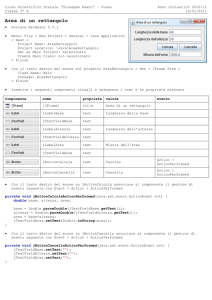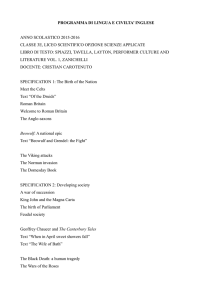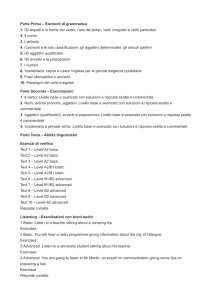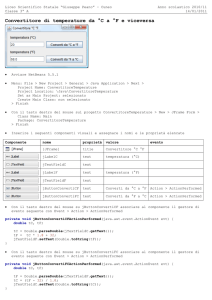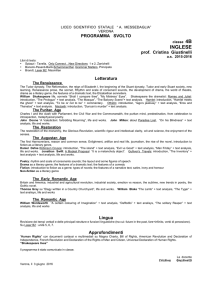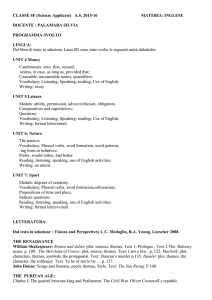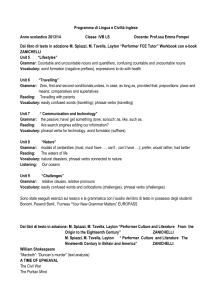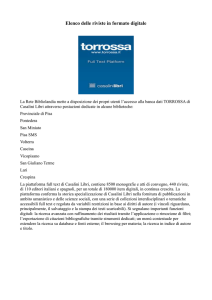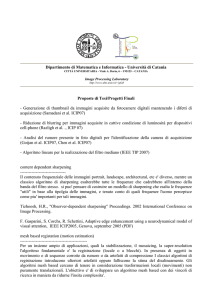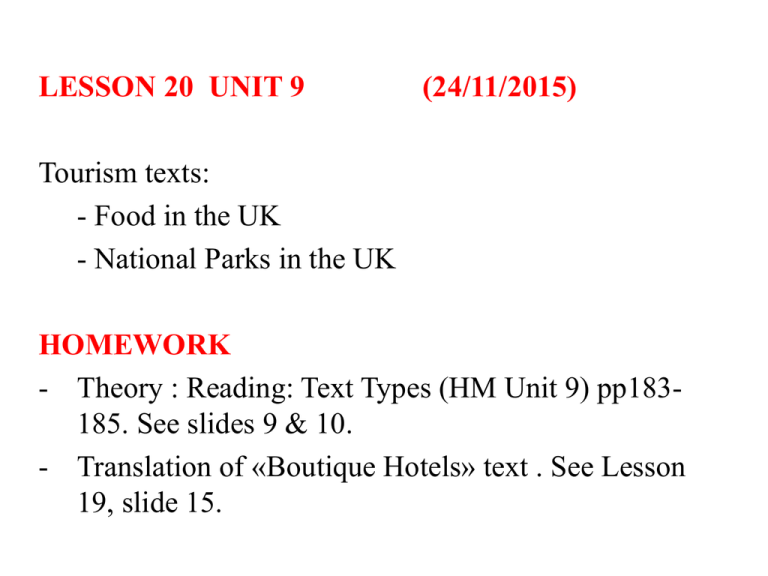
LESSON 20 UNIT 9
(24/11/2015)
Tourism texts:
- Food in the UK
- National Parks in the UK
HOMEWORK
- Theory : Reading: Text Types (HM Unit 9) pp183185. See slides 9 & 10.
- Translation of «Boutique Hotels» text . See Lesson
19, slide 15.
Remember to use the following strategies (see lessons 1 and
2):
- reordering (dislocation) to maintain the same emphasis
- equation (equivalent term) or substitution (different term)
- expansion or condensation (more or less elaboration than the
source text to help the reader’s comprehension)
- divergence (choose one suitable term from a range of
alternatives e.g., nipote niece / nephew ) and convergence
(the opposite : niece / nephew ‘nipote’: two or more terms
in the ST are one term in TT)
- paraphrase
- omission or addition
- appropriate collocations, idioms and other fixed expressions
(e.g., ‘culture and heritage’ ‘cultura e patrimonio’
Jamie Oliver: Britain’s most passionate chef talks UK food
See why Jamie Oliver can’t get enough of Britain’s food and learn a
few tips for seeking out the best UK produce.
Not content with single-handedly saving British school dinners and
giving disadvantaged kids a leg up, Jamie Oliver also opened some
of the best restaurants around. He’s part of a reborn UK eating
scene that’s seen Britain fall in love with fine produce, locally
sourced ingredients and innovative cooking.
With London leading the way as the world's most exciting dining
city, you’ll find restaurants serving food from every corner of the
world, cosy pubs with traditional menus, sophisticated eateries
offering internationally celebrated cuisine and more. So whether
you want crab sandwiches on a sun-drenched Devon quayside, the
sweetest Scottish raspberries, tempting Gower Salt Marsh Lamb or
culinary magic at Heston Blumenthal’s world-famous Fat Duck
restaurant, you’ll find British food a feast of inspiration.
Jamie Oliver: Lo chef più ardito del Regno Unito parla della cucina
britannica
Scoprite perché Jamie Oliver adora la cucina del Regno Unito e i consigli
giusti per ricercare i migliori prodotti del territorio inglese.
Jamie Oliver è un personaggio: non solo ha contribuito a migliorare le
mense delle scuole britanniche aiutando i ragazzi in difficoltà, ma ha
anche promosso l’apertura di alcuni dei migliori ristoranti del Paese. È
uno dei principali protagonisti della rinascita della scena culinaria inglese
che ha spinto il Regno Unito a concentrarsi su prodotti di qualità,
ingredienti locali e ricette innovative.
Londra è indubbiamente il centro culinario più importante del Paese, ma
non mancano altrove ristoranti dove si possono gustare ricette originarie
di ogni angolo della terra, comodi pub con menu tradizionali, raffinate
trattorie con piatti della cucina internazionale e molto altro ancora. Se
volete provare i famosi sandwich alla polpa di granchio su un soleggiato
molo del Devon , i dolcissimi lamponi scozzesi , oppure farvi tentare dal
Gower Salt Marsh Lamb o dalla magia culinaria del famosissimo
ristorante The Fat Duck di Heston Blumenthal, la cucina britannica non vi
deluderà.
NATIONAL PARKS
South East: New Forest | South Downs
The New Forest National Park is celebrated for its ancient
woodland and heathland first given protection by William the
Conqueror nearly 1,000 years ago. Ponies graze on wild heaths
speckled with purple heather and wild deer flit beneath gnarled oak
and beech trees. To the east of the New Forest lie the South Downs,
an area stretching 100 miles from the edge of Winchester to Beachy
Head. It’s best known for its famous rolling downlands that lead to
the white, sheer cliffs at Seven Sisters and Beachy Head.
Heart of England: Peak District
Britain's first national park and Europe's busiest is a diverse
landscape, comprising heather-sprayed moorland, murky limestone
caves, gentle hills and gritstone outcrops. It straddles several
counties in central northern England, is a centre for rock climbing
and is the landscape that inspired Jane Austen.
PARCHI NAZIONALI
Sud Est: New Forest | South Downs
Il Parco Nazionale della New Forest è noto per i suoi boschi e le sue
brughiere, tutelate per la prima volta nella storia durante il regno di
Guglielmo il Conquistatore, quasi mille anni fa. I pony pascolano liberi in
un delizioso paesaggio verde punteggiato dalle macchie violacee
dell’erica perenne, e i cervi si muovono circospetti tra querce secolari e
faggi selvatici. Ad est della New Forest si trova la regione dei South
Downs, un’area che si estende per quasi duecento chilometri, da
Winchester a Beachy Head. Nota per lo splendido paesaggio ondulato e le
dolci colline che scendono fino al mare, si congiunge con le bianche
scogliere a strapiombo di Seven Sisters e Beachy Head.
Inghilterra centrale: Peak District
Il Parco Nazionale più importante del Paese e più visitato d’Europa si
compone di paesaggi diversi: brughiere ricoperte d’erica, grotte scavate
nella roccia calcarea, dolci colline e affioramenti rocciosi. Si estende sui
territori di varie contee dell’Inghilterra del Nord e fu fonte di ispirazione
per Jane Austen durante la stesura dei suoi capolavori.
NATIONAL PARKS (continued)
North West: Lake District
From 16 sparkling lakes and England’s highest mountains, to sheltered
valleys and salty seascapes, Cumbria and the Lake District have inspired
and captivated generations of visitors and famous writers and poets such
as William Wordsworth and Beatrix Potter. But there’s more to see than
just scenery. The area has a rich heritage to discover, a vibrant and
contemporary cultural scene, and a growing reputation for fine food and
drink.
North East: Northumberland | North York Moors | Yorkshire Dales
Listen to the call of the upland birds, saunter through picturesque villages
of honey sandstone, build sandcastles or sit and watch the world go by. All
around are the signs of past generations - historic abbeys, embattled
castles, churches, crosses and ancient trackways. Northumberland
National Park stretches from Hadrian’s Wall to the Scottish border while
the North York Moor spread westwards from the east coast of Yorkshire.
The Yorkshire Dales park straddles the central Pennines in the counties of
North Yorkshire and Cumbria and is a favourite destination for walkers,
cyclists and horse-riders.
Nord Ovest: Lake District
Con i loro 16 laghi e le montagne più alte d’Inghilterra, con le loro ridenti valli e
spettacolari marine, il Cumbria e il Lake District hanno ispirato e catturato
generazioni intere di scrittori e poeti, come William Wordsworth e Beatrix Potter,
e attratto centinaia di migliaia di turisti. Ma c’è molto altro da fare e da vedere
qui, oltre ad ammirare gli splendidi panorami mozzafiato. La regione offre
importanti siti di interesse storico e uno scenario culturale vibrante e
contemporaneo, e ha un’ottima reputazione culinaria.
Nord Est: Northumberland | North York Moors | Yorkshire Dales
Ascolta il richiamo degli uccelli dell’altopiano, passeggia attraverso pittoreschi
villaggi di pietra arenaria color miele, siediti a costruire castelli di sabbia o rimani
semplicemente qui, immobile ad ammirare la natura. Tutt’intorno a te vedrai
vestigia di epoche storiche diverse – antiche abbazie, chiese, croci che costellano
storici sentieri. Il Parco Nazionale del Northumberland si estende dal Vallo di
Adriano ai confini con la Scozia, mentre il Parco di North York Moor parte dalla
costa orientale dello Yorkshire e si allunga verso ovest. Il Yorkshire Dales Park,
invece, comprende la catena dei Monti Pennini delle contee di Yorkshire e
Cumbria, ed è una delle mete preferite di podisti, ciclisti e appassionati di
equitazione.
THEORY: Hm Unit 9: The importance of TEXT TYPE in
translation
pp 67 – 79. And pp 183- 185: three different text types with
different communicative functions:
a) Text type: informative. Plain communication/reportage of facts
(news, knowledge, arguments, opinions, instructions). Here, the
topic itself is in the foreground of the communicative intention.
Interlingual translation should transmit the original information
in full, but also without unnecessary redundancy.
b) Text type: expressive. Creative composition, and artistic
shaping of the content. Here the sender is in the foreground. The
author of the text follows his or her own creative will and
exploits the expressive and associated possibilities of the
language. So the text is doubly structured: first on the syntactic
semantic level, and second on the level of artistic organisation.
c)
Text type: operative (designed to elicit a desired response
from the reader, e.g, persuasion, sympathy, understanding).
The text aims to stimulate action or reaction on the part of
the reader. So this is a more psychological text type. e.g.,
advertisements, tourism texts, political propaganda. The
translation should have the same effect on the behaviour of
the TL reader as the original text had on the behaviour of the
SL reader.
Implications of this:
p.74 Text types can be seen as guidelines which translators
instinctively refer to when choosing translation strategies. p.73
For example, metaphors in predominantly expressive texts are best
rendered metaphorically, whilst metaphors in predominantly
informative texts may if necessary be modified or rejected.

